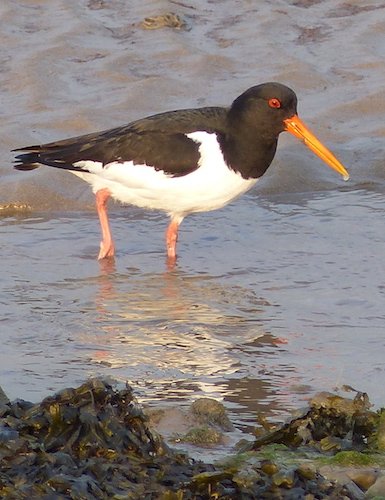Dublin

Birding Dublin
Dublin is located on the east coast of Ireland in the province of Leinster. The area held county status until its dissolution as such in 1994. County Dublin, or more correctly today the Dublin Region, is the area that contains the city of Dublin, the capital and largest city of the state of Ireland as well as the largest city on the island of Ireland; and the modern counties of Dun Laoghaire-Rathdown, Fingal and South Dublin. The Dublin Regional Authority is the regional authority for the region. Dublin was one of the oldest of the Counties of Ireland to be formally structured.
Dublin is situated at the mouth of the River Liffey and encompasses a land area of approximately 115 square kilometres (44 sq mi) in east-central Ireland. It is bordered by a low mountain range to the south and surrounded by flat farmland to the north and west. The Liffey divides the city in two between the Northside and the Southside. Each of these is further divided by two lesser rivers – the River Tolka running southeast into Dublin Bay, and the River Dodder running northeast to the mouth of the Liffey. Two further water bodies – the Grand Canal on the southside and the Royal Canal on the northside – ring the inner city on their way from the west and the River Shannon. The River Liffey bends at Leixlip from a northeasterly route to a predominantly eastward direction, and this point also marks the transition to urban development from more agricultural land usage.Similar to much of the rest of northwestern Europe, Dublin experiences a maritime climate with cool summers, mild winters, and a lack of temperature extremes.There are many green-spaces around the city, and Dublin City Council manages over 1,500 hectares (3,700 acres) of parks. Public parks include the Phoenix Park, Herbert Park and St Stephen’s Green. The Phoenix Park is about 3 km (2 miles) west of the city centre, north of the River Liffey. Its 16-kilometre (10 mi) perimeter wall encloses 707 hectares (1,750 acres), making it one of the largest walled city parks in Europe. It includes large areas of grassland and tree-lined avenues, and since the 17th century has been home to a herd of wild Fallow deer.
-
Bird Watching Dublin
WebpageDublin is the capital city of Ireland and it has dozens of places for birding and birdwatching enthusiasts. There are a surprising number of birdwatching locations where you can go bird watching in Dublin. Sea birds and harbour birds can be seen in Bull Island, Dun Laoghaire and the Great South Wall. There are also several small harbours along the Dublin coastline including Skerries, Rush and Colliemore harbour. Colliemore has a ferry service to Dalkey Island where you can also see seals, rabbits and a flock of wild goats! -
The 9 Best Places for Birdwatching in Dublin
WebpageOver 250 species of bird have been recorded in Dublin and most of the birding sites are accessible by public transport!
-
Dick Coombes
-
BirdWatch Ireland - South Dublin Branch
WebsiteThe South Dublin Branch of BirdWatch Ireland, the national NGO wild bird conservation group, has around 2,500 members in the south city and Dun Laoghaire/Rathdown catchment area. -
Birdwatch Ireland - Fingal Branch
WebsiteWelcome to the Fingal branch of Birdwatch Ireland. Fingal is situated in North Co. Dublin and can boast of great birding spots for the beginner and experienced birder alike. Fingal extends from the outer limits of Dublin city to Meath in the North and to the West
-
NR Rogerstown
WebpageSatellite ViewThe Rogerstown Nature Reserve is set within the inner Rogerstown estuary - a relatively small, narrow and extremely shallow estuary with extensive mudflats at low tide. The reserve was an area of reclaimed land used as grazing pasture, but is now being restored back to saltmarsh. The saltmarsh is inundated with sea water to varying degrees on a daily basis. It is during these times that the brackish grasslands and inter-tidal creeks are extremely important for birds, providing safe roosting sites for thousands of wintering wildfowl and waders. The soft mud flats, exposed during low tides, are their feeding areas. The winter time is when Golden Plover, Lapwing, Curlew, Black-tailed Godwits, Dunlin, Redshank, Light-bellied Brent Geese, Shelduck, Wigeon and Teal are numerous. During the summer Lapwings breed and the surrounding trees are home to a variety of summer visitors, such as Willow Warblers, Chiffchaffs and Blackcaps, especially within the Turvey Parklands, managed by Fingal County Council. -
NR Shenick Island
InformationSatellite ViewThe Shenick Island Reserve is one of a group of three islands situated just offshore from the town of Skerries. The reserve is connected to the mainland by sandflats exposed at low tide. During the summer months, a small population of Fulmars breed on the low lying cliffs, as do Herring and Great Black-backed Gulls. In winter the islands are frequented by Light-bellied Brent Geese and waders such as Oystercatchers feeding around the shore. Short-eared Owls may be seen hunting over the middle of the island.
-
2024 [03 March] - Brian Carruthers
PDF ReportThe Hide is a large cargo container fitted with a timber interior and raised 2 meters off the ground...
